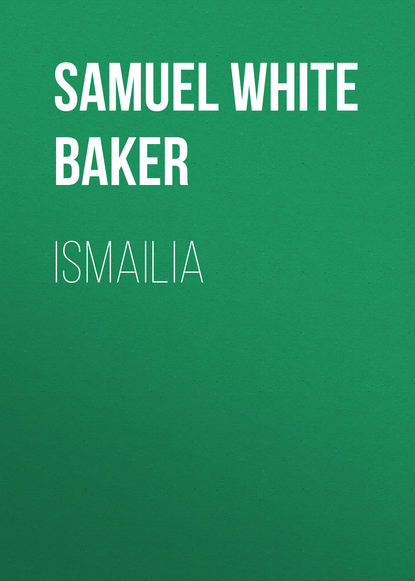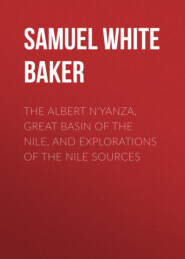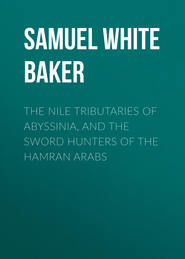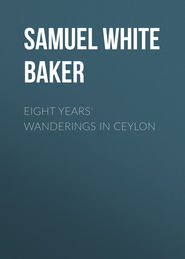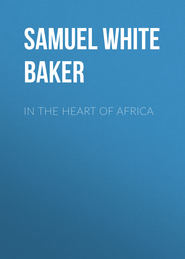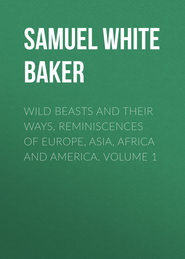По всем вопросам обращайтесь на: info@litportal.ru
(©) 2003-2024.
✖
Ismailia
Настройки чтения
Размер шрифта
Высота строк
Поля
My opinion has been frequently asked on this subject, and many have endeavoured to persuade me that a rapid change and improvement of the natives may be effected by such an agency. I cannot resist by argument such fervent hopes; but if good and capable men are determined to make the attempt, they may now be assured of peace and security at Gondokoro, where they will have the advantage of the good name left by the excellent but unfortunate members of the late Austrian mission.
GEOGRAPHY
I have not changed my opinions that have already been expressed in "The Albert N'yanza," except that, from the native testimony, I presume there must be a channel which connects either a lake or series of lakes with the Albert N'yanza.
Without a guide, it would be a work of much time and difficulty to discover the true channel among the labyrinth-like inlets that characterize the vast beds of floating water-grass.
Many years ago, when at Magungo, on the Albert N'yanza, I could not at first believe that the raft-choked entrance of the Victoria Nile in apparently dead water was indeed the mouth of that important river. My subsequent experience in the marshy and lacustrine Bahr Giraffe has confirmed my impressions of the extreme difficulty of deciding upon the non-existence of a channel until after a lengthened investigation.
I cannot conceive that the Lualaba of Livingstone can be included within the Nile Basin. Livingstone decided the level of the Tanganyika lake to be within 72 feet of my level of the Albert N'yanza. With the same instruments he determined the altitude of the Lualaba to be lower than the Albert N'yanza, thus showing the impossibility of a connection between that river as an affluent with the lake.
I will not presume to assert that the Lualaba is a source of the Congo, as I have a strong objection to geographical theories or assertions unless proved by actual inspection, but if Livingstone's observations for altitude are correct, it is impossible that the Lualaba can be connected with the Nile.[19 - Mr. Stanley's discoveries since this was written have confirmed my suppositions.]
Dr. Schweinfurth's discovery of the Welle river flowing towards the west, between the 3rd and 4th deg. N. lat., is a clear proof that no river can be running from the south to the north-east towards the Nile Basin, otherwise the Welle river would be intersected.
In page 186, vol. ii., Dr. Schweinfurth[20 - "The Heart of Africa."] writes:—"Its course [the Lualaba], indeed, was towards the north; but Livingstone was manifestly in error when he took it for a true source of the Nile, a supposition that might have some semblance of foundation originating in the inexplicable volume of the water of Lake M'wootan (Albert N'yanza), but which was negatived completely as soon as more ample investigation had been made as to the comparative level, direction, and connection of other rivers, especially of the Welle."
Although Dr. Schweinfurth was unprovided with astronomical instruments, we may place thorough reliance in the integrity and ability of this traveller, who has taken the greatest pains to arrive at true conclusions. I am quite of his opinion, that the Welle is outside the Nile Basin, and drains the western watershed.
In a letter from Dr. Livingstone addressed to Sir Bartle Frere, dated Lake Bangweolo, 27th Nov. 1870, he writes:—" The Tanganyika, whose majestic flow I marked by miles and miles of confervae and other aquatic vegetation for three months during my illness at Ujiji, is, with the lower Tanganyika, discovered by Baker, a riverine lake from twenty to thirty miles broad."
It is thus clear that Livingstone considered that the Tanganyika and the Albert N'yanza were one water. On 30th May, 1869, dated Ujiji, he writes to Dr. Kirk:—"Tanganyika, N'zige Chowambe (Baker?) are one water, and the head of it is 300 miles south of this."
"The majestic flow" of confervae remarked by Livingstone on the Tanganyika is beyond my comprehension, if that vast lake has no outlet at the north.
In Livingstone's letter of 27th Nov., 1870, he writes:—"Speke's great mistake was the pursuit of a foregone conclusion. When he discovered the Victoria N'yanza he at once leaped to the conclusion that therein lay the sources; but subsequently, as soon as he and Grant looked to the N'yanza, they turned their backs on the Nile fountains. Had they doubted the correctness of the conclusion, they would have come west into the trough of the great valley, and found there mighty streams, not eighty or ninety yards, as their White Nile, but from 4,000 to 8,000 yards, and always deep."
I was surprised that Livingstone could make such an error in quoting Speke's White Nile from the Victoria N'yanza as eighty or ninety yards in width! At M'rooli, in latitude N. 1 degree 37", I have seen that magnificent river, which is at least A THOUSAND YARDS in width, with a great depth. I have travelled on the river in canoes, and in the narrowest places, where the current is naturally increased; the width is at least 300 yards.
From my personal experience I must strenuously uphold the Victoria Nile as a source of enormous volume, and should it ever be proved that the distant affluents of the M'wootan N'zige are the most remote, and therefore the nominal sources of the Nile, the great Victoria N'yanza must ever be connected with the names of Speke and Grant as one of the majestic parents of the Nile Basin.
Latterly, when speaking of the Lualaba, Livingstone writes to Sir Henry Rawlinson:—"The drainage clearly did not go into Tanganyika, and that lake, though it probably has an outlet, lost all its interest to me as a source of the river of Egypt."
We are, therefore completely in the dark concerning the flow of water from the Lualaba south of the equator, and of Schweinfurth's Welle north of the equator, but both these large rivers were tending to the same direction, north-west. The discovery of these two rivers in about the same meridian is a satisfactory proof of the western watershed, which completely excludes them from the Nile Basin. If the Tanganyika lake has no communication with the Albert N'yanza, the old Nile is the simple offspring of the two parents—the Victoria and the Albert lakes. (This is now proved to be the case.)
When the steamer that I left at Gondokoro in sections shall be launched upon the Albert N'yanza, this interesting question will be quickly solved.
Early in November, 1871, when I was on the Nile south of Regiaf, I noticed the peculiar change that suddenly took place in the river. We were then in N. lat. 4 degrees 38", below the last cataracts, where the water was perfectly clear and free from vegetation, with a stream of about three and a half or four miles per hour.
Suddenly the river became discoloured by an immense quantity of the
Pistia Stratiotes, of which not one plant was entire.
This aquatic plant invariably grows in either dead water or in the most sluggish stream, and none existed in the part of the river at N. lat. 4 degrees 38".
I examined many of the broken plants, which, instead of floating as usual on the surface, were mingled in enormous quantities with the rushing waters. None were rotten, but they had evidently been carried down the numerous rocky waterfalls which occupy the interval between N. lat. 3 degrees 34" and 4 degrees 38", and were thus bruised and torn asunder.
The extraordinary influx of damaged aquatic plants continued for many days, and unmistakably denoted the rise in the level of the Albert N'yanza at that season (say 1st Nov.). Above the falls, in N. lat. 3 degrees 32", there is very little current in the broad deep Nile; and in about N. lat. 3 degrees this river is several miles in width, with no perceptible stream. In those propitious calms the Pistia Stratiotes grows in vast masses along the shores, and the annual rise of the lake creates a current which carries the plants towards the cataracts, and consequent destruction.
By this sign I conclude that the maximum of the Albert N'yanza would be during the month of November.
LANGUAGES
The following list of words will afford a fair example of the differences in language of the various tribes between Gondokoro and the equator:
Lobore. Bari. Shooli. Unyoro.
A fowl … … A-oo. Chokore. Gweno. Unkoko.
A mat … … Gallaca. Tero. Kaboone. —
Flour … … Arafoo. Bolo. Mocha. Obsano.
Fire … … Arsi. Kemang. Mai. Moora.
Water … … Yee. Feeum. Pee. Maizi.
Milk … … Leh. Leh. Chak. Amattai.
A cow … … Tee. Kitang. Deaug. Inte.
A bull … … Moniko. Moni. Tu-an. —
A dog … … Orke. Diong. Gunoah. —
Rain … … Yee. Koodoo. Kort. Injoore.
The sun … … Yetakali. Narlong. Tschen. Musanne
A chief … … rpi. Mattat. Ruort. Matongali
A sheep … … abeelo. Kabisho. Ramo. Imbuzi.
A goat … … ndree. Keene. Deall. Imbuzi.
The moon .. … mbah. Yarfah. Dooe. Quezi.
The stars . … eebi. Katchikoo. Lakori. Nynerzi.
Flesh … … sah. Lokore. Reugo. —
Dhurra (corn) . sih. Keemak. Gyah. —
A basket .. … voch. Soodah. Adooku. —
Beads … … ecoh. Sooksook. Teko. Unguanze.
Coracan Elcusine Loque. – Kaal. Burroi.





